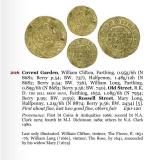
1610 Mary Long 1661 tokens

about 1610 - 1674
Master vintner1
about 1610 |
Born |
21st Feb 1632/3 |
St Dunstan in the East |
21st Feb 1632/3 |
Married William LONG in ,London.3 |
about 1633 |
Birth of daughter Mary LONG |
about 1634 |
Birth of son Thomas LONG in ,London |
about 1635 |
Birth of daughter Elizabeth LONG |
1637 |
Birth of daughter Constance LONG in ,London |
about 1639 |
Birth of daughter Beatrix LONG |
about 1640 |
Birth of son James LONG |
about 1642 |
Birth of son Benjamin LONG |
about 1643 |
Birth of daughter Sarah LONG |
about 1645 |
Birth of son William LONG |
about 1646 |
Birth of son John LONG |
about 1648 |
Birth of son Richard LONG in ,,England |
about 1650 |
Birth of daughter Deborah LONG |
about 1650 |
Birth of daughter Anne LONG |
about 1651 |
Birth of son Henry LONG |
about 1652 |
Birth of son Joseph LONG |
1661 |
Death of William LONG in ,London |
1662 |
Occupation Master vintner in ,London.1 Holmes John son of John, Cullompton, Devon, clothier to Mary widow of William Long, 7 Oct 1662, Vintners' Company |
1663 |
Occupation Master vintner in ,London.1 Bowler Edward son of Philip citizen and cordwainer, deceased, to Mary widow of William Long, 7 Jul 1663, Vintners' Company |
1665 |
Occupation Master vintner in ,London.1 Hurly Joseph son of Roger, Taunton, Somerset, clothworker to Mary widow of William Long, 7 Feb 1664/5, Vintners' Company |
1667 |
Occupation Master vintner in ,London.1 Ryland Edward son of Roger, Macclesfield, Cheshire, tanner to Mary widow of William Long, 5 Feb 1666/7, Vintners' Company |
1669 |
Occupation Master vintner in ,London.1 King Thomas son of William, Abingdon, Berkshire, tailor to Mary widow of William Long, 6 Jul 1669, Vintners' Company |
1671 |
Occupation Master vintner in ,London.1 Palmer William son of John, Hampton, Middlesex, chirurgeon, deceased, to Mary widow of William Long, 3 Oct 1671, Vintners' Company |
1672 |
Occupation Master vintner in ,London.1 Vyner William son of William, Cumnor, Berkshire, yeoman to Mary Long, widow 12 Nov 1672, Vintners' Company |
1674 |
Died in ,London |
9th May 1674 |
Probate in ,London.2 |
Page created using GEDmill 1.11.0